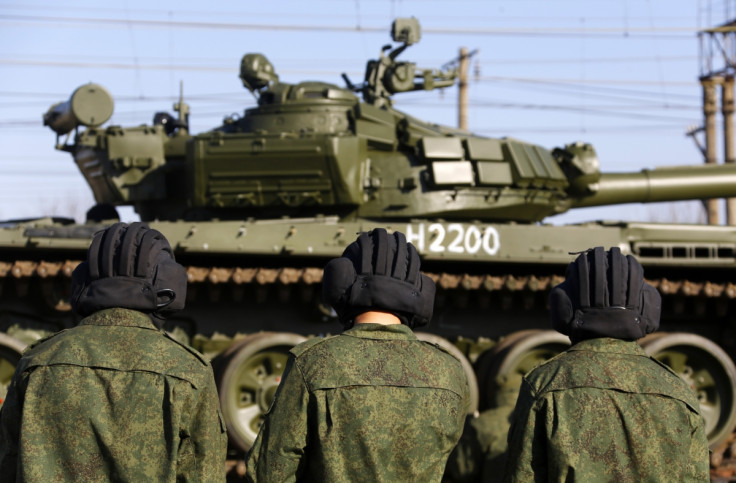Ukraine, Russia and the Crimea: A History

On Saturday, 29 March 2014, despite a very heavy Russian military presence on the borders of Ukraine and Russian troops firmly in control of Crimea, Russia's Foreign Minister Sergei Lavrov, assured the West and in particular the United States, that his country has no intention of invading its neighbour. Possibly, more as a token of goodwill for previous talks have produced so little, Mr Lavrov agreed to meet US Secretary of State John Kerry in Paris on Sunday, 30 March.
With an army of between 40,000 and 50,000 fully prepared troops carrying out "exercises" immediately across Ukraine's eastern frontier and over twice that number spread along and near other strategic locations of the Russian - Ukrainian border, it is difficult to see any tangible results arising from such talks and Russia's actions fall well short of the commitment to pull back troops which the European Union (EU) and America want to see.
As for the Russian troops in Crimea, that is a little more complicated than the West wants to recognise but they are unlikely to leave any time soon.
Under Russian law at least, their troops have a legitimate right to be in Crimea now that it has returned to the Motherland but complicating matters is the fact that Russia had retained the right to maintain its armed forces there to certain agreed levels and categories, after Ukrainian independence on 24 August 1991.
This was one reason why the Black Sea port and base of Russia's Black Sea Fleet, Sevastopol (342,000) and its surrounds, covering some 334 square miles, was a "closed city" during the Soviet era and a "city of special status" after Ukraine became independent.
Apart from the Black Sea Fleet and its base(s) and facilities, Russia retained the right to have up to 25,000 ground troops in Crimea at any one time and in recompense for all this, agreed to pay by way of a write-off, $98 million of Ukraine's debt per year, owed to Russia.
Adding to the confusion is the fact that Crimea's status continued to be a bone of contention within the Russian parliament well after that body had recognised the rest of Ukraine as a separate country, not least because the Crimean Oblast (province) had been transferred to Ukraine as a "symbolic gesture".
The transfer of Crimea which had been part of Russia under Catherine the Great since 1783 (and never part of Ukraine) was made in February 1954 by General Secretary, equivalent of President, Nikita Khrushchev on Ukraine's 300<sup>th anniversary as part of the Russian Empire. There are rumours that Mr Khrushchev was intoxicated at the time.
Whether or not this is true, his protégé and successor, Leonid Brezhnev saw no reason for alarm. Although Mr Brezhnev was a Ukrainian, born in Dniprodzerzhynsk, he was a man who described himself alternately as "Ukrainian" and "Russian", in like manner to "English" and "British", for he saw no difference. Both men had been political commissars in the Red Army during World War II and both had attained the rank of general. Over 4.5 million Ukrainians served in the Red Army during the War.
The unease regarding Crimea after 1991, was not in Moscow alone. Following a period of uncertainty, during which in 1992 the Crimean parliament declared itself to be an independent Republic, the Russian parliament, apparently in response, voted to void the cession of Crimea to Ukraine.
There was however, considerable dissatisfaction and dissent by this time felt by all parties over the status of the Crimea which seems to have existed in a kind of limbo, not least by most Russians living there and who made up about 70 per cent of the total population. This proportion would have been higher but for the fact that Crimean Tatars were beginning to return from exile in Siberia and formed about 10 per cent of the Crimean population.
In 1994, Ukrainian-born but political Russian nationalist Yuriy Meshkov, who had been a member of Crimea's parliament since 1990, stood in Crimea's presidential election on a platform not simply demanding closer ties with Russia but the annexation of Crimea by Russia. Mr Meshkov won 73 per cent of the vote but on taking office his methods proved far too unorthodox (and illegal), even going so far as to appoint a Russian national as vice Prime Minister, and he was removed from office in March 1995.
Before Mr Meshlov's removal from office his actions had caused such instability as to finally get a major power agreement to resolve the situation. On 05 December 1994, Ukraine and Russia signed the Budapest Memorandum on Security Assurances.
Important clauses include: respecting Ukrainian independence and sovereignty within its existing borders; refraining from the threat or use of force against Ukraine; refraining from using economic pressure on Ukraine in order to influence its politics; and to consult with one another if questions regarding these commitments arise.
Full signatories to the Memorandum were Russia, USA and the UK with China and France signing (weaker) individual assurances.
All settled then? Maybe not as the clauses on borders and status could be open to interpretation after the Ukrainian parliament revoked Crimea's constitution in 1995 and abolished certain offices, forcing on the Autonomous Republic a new, watered-down constitution in 1998.
Meanwhile, Russia's demands in Paris, put to Mr Kerry, is for the Ukraine to become a federation with degrees of autonomy to safeguard its different minorities – Russians in the main – and a further agreement that Ukraine will become a neutral state.
We've seen twists and turns in the status of Crimea ever since Ukraine became independent. At that rate, sorting out Ukraine could take us into the next century!
© Copyright IBTimes 2025. All rights reserved.






















